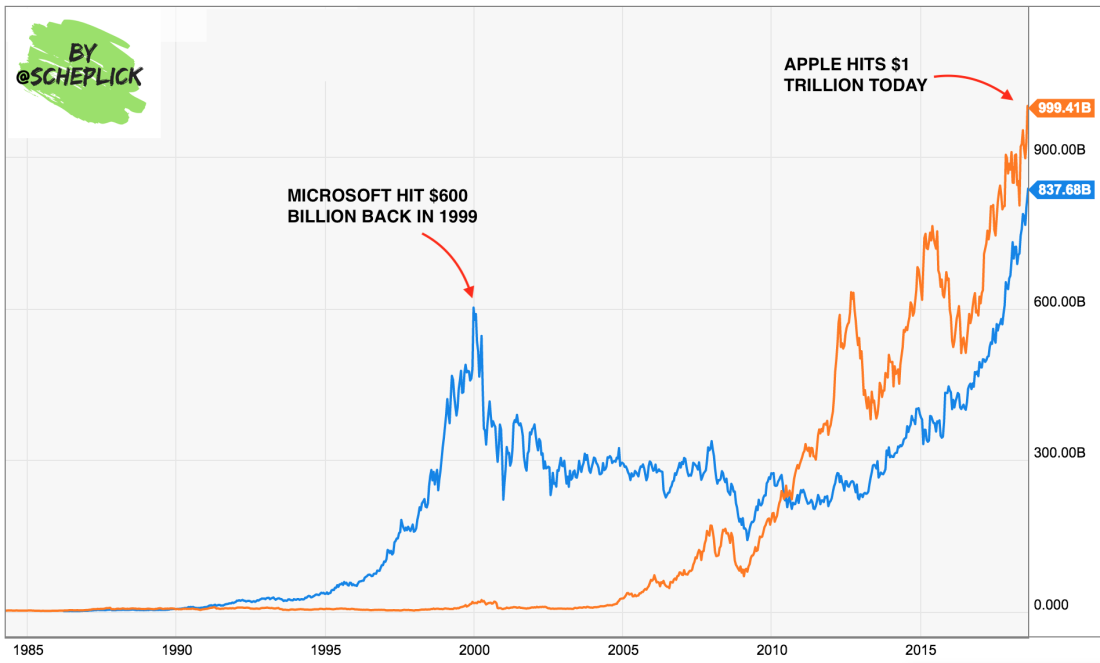This post has been written by Stefan Cheplick. You can follow him on Twitter and read his blog for more articles.
Everyone is going wild about Apple hitting $1 trillion.
I get it.
There’s never been a company worth $1 trillion by market cap. My gawd. What a world we live in. Maybe Buffett was right when he said that “Today’s babies are the luckiest crop in history.”
Let’s take a step back.
Let’s take a step back!
I love saying that phrase.
Let’s look at the whole picture.
A company does not magically hit $1 trillion. There’s a formula behind it, and it’s often forgotten. There are 4,829,926,000 shares of Apple outstanding. These shares are traded, held, bought or sold each day.
A share of Apple is traded at any moment and the price is quoted in real-time from 9:30am ET to 4:00pm ET. Go ahead, open your Interweb, type in, “the price of AAPL.” Boom. That’s how much a single share is going for right now.
Next, take that number and multiply it by the number of shares outstanding. These are all the Apple shares in the world whether they’re held in Steve Jobs’ trust or by some high school kid who just bought his first stock ever with a few dollars from his dad. Now that’s a lucky kid. Millennials? Come on, let’s start talking about the Generation Z squad.
When Apple first hit $1 trillion, each share traded for $207.05. $207.05 x 4,829,926,000 shares = $1,000,036,178,300.00. That’s the whole pie. If one share is going for $207.05, theoretically they all should go for $207.05. That makes the entire pie in the sky named Apple worth one trillion greenbacks.
There’s some inherently wrong with framing a company as simply something worth $1 trillion. In my opinion, understanding this is what separates the best investors from the rookies. It gets more complicated, but if you can hang, then you just really stepped up your understanding of markets and economics.
“I sometimes ask myself how it came about that I was the one to develop the theory of relativity. The reason, I think, is that a normal adult never stops to think about the problem of space and time.”
— Albert Einstein
Space and time.
Let that sink in.
There are similarities in the hard sciences that relate to markets. Maybe that’s why the quant funds are taking over.
A stock moves throughout time. Its shares are traded and exist within the context of society at any given moment. One way to think of that is to imagine what $1 trillion means today relative to $1 trillion 15 years ago. Without context, simply exclaiming $1 trillion is meaningless. It is an abstraction. We need that numerus numeratus.
Let me now get to the example I have been meaning to get to. This is primarily geared at people who can’t grasp a company worth $1 trillion. Maybe they think it’s a farce. Or maybe they think it’s a scam, bubble, or just nonsensical. I often remind myself that the first bubble is never the last and that it can always get worse or it can always get better.
If you adjust Apple’s market cap to reflect what was happening during the DotCom Bubble of 1999, the absolute peak of tech euphoria, the notorious b-u-b-b-l-e, you would find that $1 trillion today translates to just $661 billion back then. I say “just” because whoa, that’s a 33% difference.

$1 trillion? Brah, we need $8 trillion to get this party started.
At the peak of the DotCom Bubble, Microsoft’s market cap exceeded $600 billion. So in 1999, when there was less connectivity, less prosperity, less total money in circulation, less credit, and basically less everything else, a company managed to hit $600 billion. Now that’s impressive. If you adjust Microsoft’s milestone in 1999 to reflect today’s dollars, its market cap would be $910 BILLION. If you still don’t think that’s incredible, keep reading.
When Microsoft hit that level in 1999, it was doing about $19 billion in annual revenue. When Apple hit that level, it was doing more than $200 billion annual revenue. Microsoft was trading a price-to-sales ratio of 32. That means people were buying one share of Microsoft for 32 TIMES the amount of sales it was doing. If the same applied to Apple today, Apple would trade for more than $8 TRILLION.
Relativity, man.
The lesson here is one that cannot be stated enough. It presents an opportunity, it displays a more clear picture, and it’s a healthier way to think about markets and money. You need to apply relativity. One way of doing that is by adjusting certain numbers. That might be inflation, that might be sales ratios, or that might be general economic health. In every instance, you are comparing and contrasting the differences in time and space.
Thank you, Einstein.
Thank you, Jobs.
And thank you, Mr. Market.
This game keeps getting more fun and more interesting.
“Game the same. Just got more fierce.”
– Slim Charles
The original post appeared on his blog and can be accessed here.